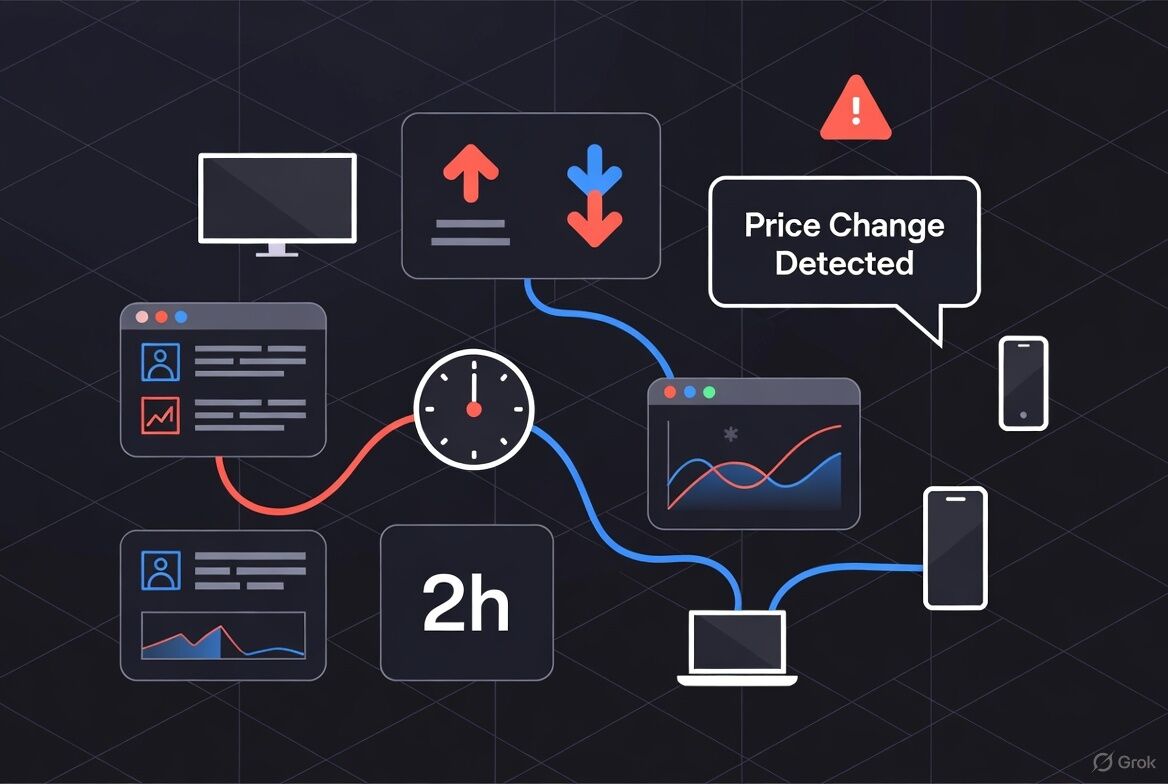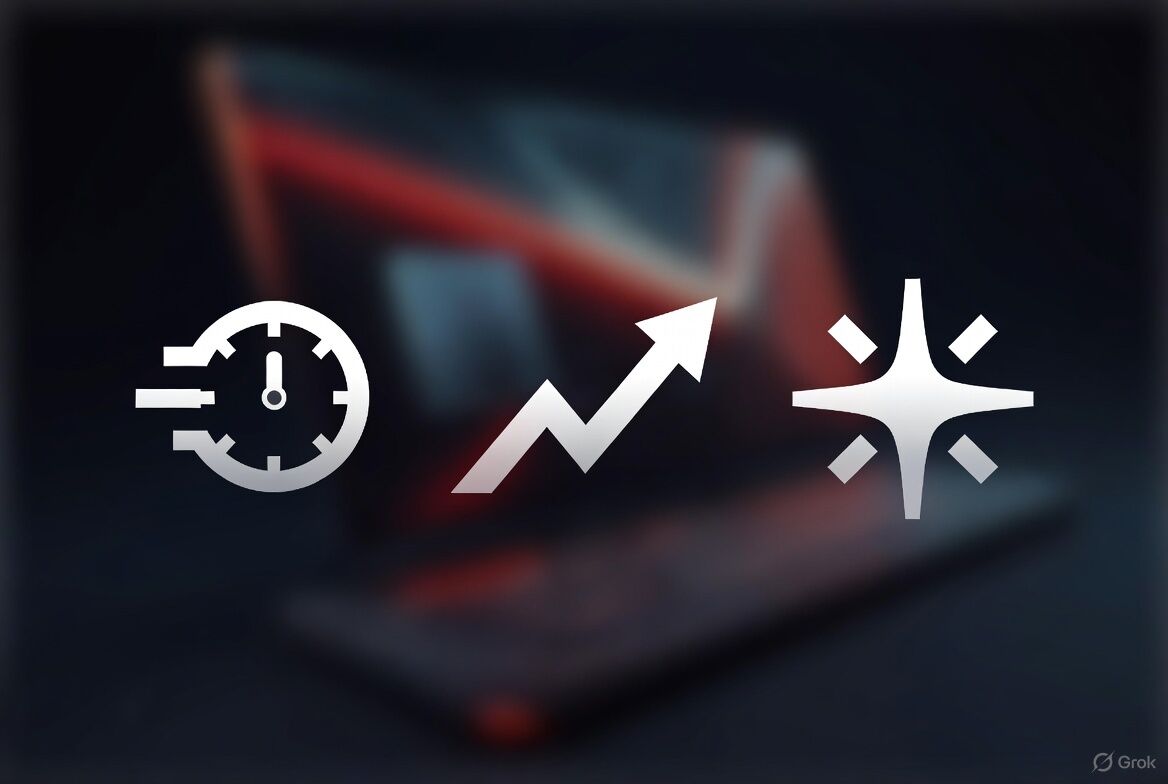How an Electronics Retailer Cut Price Response Time from 48 Hours to 2 Hours with Automated Price Tracking

Client Challenge: Slow Manual Price Monitoring
One of our clients - a mid-sized electronics e-commerce retailer was struggling to keep up with competitors’ pricing. (For confidentiality, we won’t disclose the company’s name.) Their pricing team monitored competitor websites by hand, checking prices product by product. This manual process was painfully slow and error-prone. On average, it took about 48 hours for the client to notice a competitor’s price change and adjust their own prices. In the fast-paced electronics market, a two-day lag meant lost sales and eroding market share if a competitor dropped their price, our client might remain overpriced for days.
The client’s challenge was clear: they needed to react to price changes faster. Relying on spreadsheets and occasional checks simply wasn’t sustainable. In fact, their situation was not unique. Industry research shows that 67% of online retailers still use manual price checks, spending 11-15 hours a week on it, and missing up to 92% of competitor price changes. Our client realized they were likely missing countless price adjustments and losing revenue due to delayed responses. They needed an automated solution to monitor competitors in real time and alert them immediately when prices or product availability changed.
Additionally, maintaining pricing competitiveness was crucial for them. If a popular laptop model became cheaper on a rival’s site or if a competitor ran out of stock on an item, our client wanted to know within minutes, not days. The manual workflow visiting 5 different competitor websites, searching for the same product, and recording prices was too slow and prone to human error. They also had hundreds of products to track, making it impossible to cover everything without automation. Clearly, the client needed a better way to keep an eye on 5 key competitors and thousands of product prices, all without hiring additional staff or burning out the team.
Our Solution: Automated Competitor Price Tracking & Alerts

We at Let’s Scrape knew this problem well and had the perfect solution: a custom automated price monitoring system. We worked closely with the client’s team to design a solution tailored to their needs. Here’s how we solved the challenge:
-
Custom Web Scrapers for 5 Competitor Sites: We built dedicated scrapers to navigate each of the five competitors’ websites. These scrapers were configured to find the client’s product listings (by SKU or product name) on each site and extract the current price and stock availability. We handled the nuances of each site’s HTML structure and ensured our scrapers could adapt to changes. Thanks to our robust infrastructure (10+ servers handling 650,000+ requests monthly), we ran these scrapers frequently throughout the day with high reliability.
-
Frequent Monitoring Schedule: Instead of a slow daily manual check, we set the system to check competitor prices multiple times per day. In practice, our scrapers ran on a schedule (approximately every hour) so that any price drop or increase by a competitor was caught quickly. This frequent schedule is what enabled the dramatic reduction of reaction time to about 2 hours on average often even faster.
-
Automatic Change Detection & Alerts: We implemented an alert system that would automatically notify the client whenever a significant change was detected. For example, if a competitor lowered the price of a product or if an item went out of stock on a competitor’s site, the system would immediately flag that change. We set up instant alerts via email (and an optional Slack integration) to the client’s pricing managers. This meant that within an hour or two of a competitor’s move, the relevant people at our client’s company knew about it. No more checking spreadsheets in the morning and realizing they were undercut 2 days ago now they would know almost in real time.
-
Clean Data Delivered to S3 Daily: All scraped data was aggregated, cleaned, and formatted for easy use. We applied enterprise-grade quality checks - including validation, deduplication, and completeness audits to ensure the data was accurate and trustworthy. Every day (and after each scraping cycle), the compiled pricing data was delivered as a CSV file straight to the client’s Amazon S3 bucket. The data included timestamps, competitor names, product identifiers, prices, and stock status. Because it was in CSV (structured table format), the client could easily plug it into their BI dashboards or Excel to analyze trends. This end-to-end automation (from scraping to cleaning to delivery) meant the client’s team spent zero time on data wrangling. They could focus on analysis and strategy instead of copy-pasting data.
-
Proof of Concept in 48 Hours: To build trust and ensure our solution met their needs, we developed a quick Proof of Concept (PoC) within two days. In this PoC, we set up monitoring for a handful of products on one competitor’s site and demonstrated how the alert system and data delivery would work. The client was impressed to see live data and alerts in action within 48 hours of our initial meeting. This quick turnaround proved our agility and gave the client confidence to proceed to a full-scale implementation.
-
Scalable & Compliant Implementation: Our solution was built with scalability in mind. As the client’s product range grows or if they want to add more competitors, the system can easily be extended. We also ensured full legal compliance and GDPR adherence throughout the project. We scraped only publicly available information (prices on public product pages) and respected robots.txt rules, adjusting crawling speed to avoid burdening the target sites. The client appreciated that data ethics and compliance were a priority for us it meant they could use the data without any legal worries.
Throughout the implementation, we maintained close communication with the client. We shared our experiences from similar projects and advised on best practices. For instance, we recommended the ideal frequency of checks and how to handle dynamic pricing (like flash sales or limited-time offers). We also configured the alert thresholds to match the client’s strategy e.g. alerts for any price change above a certain percentage or alerts if a competitor’s price falls below the client’s cost. Our expertise in web data extraction and pricing intelligence really shone here: we anticipated challenges like site anti-scraping measures (which we countered using rotating proxies and careful request timing) and data matching issues (we helped the client map their product catalog to each competitor’s equivalent product IDs). In short, we delivered a comprehensive, custom-tailored price tracking system that fit seamlessly into the client’s operations.
Effects and Results: Faster Decisions, Competitive Edge, Real “Wow” Impact

The results of our automated solution were immediate and powerful. The client experienced several tangible improvements and “wow” moments once everything was up and running:
-
Reaction Time Slashed from 48h to ~2h: This was the headline result. Instead of waiting two days to notice competitor price changes, the client now gets notified in near real-time. On average, it takes about 1-2 hours for our system to detect a change and send an alert. In some cases, the client has been able to match a competitor’s price the same hour the competitor changed it! This agility in pricing is a game-changer. The pricing manager at the client remarked that they went from always “playing catch-up” to now being proactive and often a step ahead of competitors.
-
Significant Time Savings (20+ Hours/Week): The client’s team saved a huge amount of manual work. Previously, they had staff spending many hours collecting and updating price data by hand. With automation, we estimate they freed up over 20 hours per week that used to be spent on tedious data gathering. This is time they now reinvest in strategy, such as analyzing pricing trends, planning promotions, and negotiating better supplier deals. Essentially, our solution eliminated an entire category of busywork. One team member joked that we gave him his Mondays back, since he no longer had to start the week with a marathon price-checking session.
-
Improved Pricing Accuracy and Revenue Protection: By never missing a competitor’s price drop, the client can now adjust their prices to stay competitive on core products. This has had a direct impact on sales and margins. For example, in the first month after implementation, the client identified and matched dozens of significant price cuts by competitors that they might have missed before. They noticed fewer instances of being undercut in the market. While exact revenue figures are confidential, the client reported that this proactive pricing approach helped them avoid revenue loss that would have occurred had they kept prices too high for days. In some cases, they even spotted opportunities to increase prices when a competitor went out of stock (capturing extra margin while still remaining the only seller). The net effect was a healthier bottom line and more confident pricing decisions.
-
Customized Alerts and Better Decision-Making: The automatic alerts for price and availability changes became an integral part of the client’s daily routine. Every morning, the team reviews a summary of any overnight changes. If a competitor’s price drops sharply or if a product becomes unavailable elsewhere, the relevant sales manager can react instantly (for instance, by running a promotional match or highlighting that product’s availability in marketing). The client described these alerts as “early warning signals” that give them peace of mind. They no longer worry that something important happened in the market without them knowing. This confidence is invaluable it shifts their mindset from reactive to proactive.
-
Data-Driven Strategy and Competitive Advantage: Having a reliable feed of competitor pricing data has unlocked new strategic insights. The client can now analyze pricing trends over time - for example, seeing if a competitor tends to discount certain gadgets on weekends or if another competitor is testing dynamic pricing on popular items. With our delivered CSV data integrated into their BI tools, the client created a dashboard to visualize price movements across competitors. This insight helped them identify patterns, such as one rival who was consistently 5% cheaper on accessories (leading our client to negotiate better supplier prices for those products). In short, our solution provided not just faster reaction times, but also a broader view of the competitive landscape, giving the client a true competitive edge.
The business outcomes were very positive. Our client could respond to market changes in hours instead of days, which in the world of e-commerce meant capturing sales that would have otherwise been lost. They also reported improved customer satisfaction by ensuring their prices were never grossly higher than competitors, customers gained trust that the client’s store always offers a fair deal. Internally, the project champion at the client company earned praise for modernizing their processes. It’s not an exaggeration to say this automation transformed their pricing operations. What used to be a pain point is now a strength.
Perhaps one of the best indicators of success: the client decided to expand the project after seeing the results. They asked us to add two additional competitor websites to the monitoring list and to begin tracking new data points such as competitors’ customer ratings and review counts (to correlate price changes with product popularity). The fact that they wanted to broaden the scope of the project shows the level of trust and value they found in our collaboration. We were, of course, happy to oblige and continue supporting their needs.
Final Thoughts

This case study demonstrates how a professional web scraping and data automation solution can solve the exact problem that many retailers face: staying on top of competitor prices. Our client went from manual, slow, and incomplete price monitoring to an automated, real-time system that empowered them to make faster and smarter decisions. The result was a measurable improvement in efficiency and competitiveness a true win-win for the client’s team and their business performance.
At Let’s Scrape, we pride ourselves on delivering these kinds of results. We combine technical expertise with a deep understanding of business needs to create solutions that make a real difference. And we always maintain our clients’ confidentiality and trust as you noticed, we haven’t revealed the client’s name or sensitive details, because we respect privacy and NDAs while sharing the essence of the success story.
Need a similar solution for your business? We’re here to help. Whether it’s price tracking, lead generation, market research, or any custom web data project, our team can likely build it. We offer a free Proof of Concept within 24-72 hours for qualified projects so you can see results before committing. Don’t let your competitors outpace you. Contact Let’s Scrape today, and let’s discuss how we can automate data collection in your organization and give you the competitive edge you’ve been looking for. Let us handle the data work, while you focus on making great business decisions.
FAQ:
-
What were the main challenges the retailer faced before automation?
The retailer monitored competitor pricing manually, which took around 48 hours on average, causing lost sales and shrinking market share. -
What exactly did the solution from Let’s Scrape involve?
A custom automated competitor-price monitoring system: web scrapers for 5 competitor sites, frequent checks (≈ every hour), automatic alerts for price or stock changes, and cleaned data delivered in CSV format. -
How quickly did the system start delivering results?
A proof of concept (PoC) was up and running within ~48 hours. After full implementation, the average reaction time dropped to about 1-2 hours. -
What were the key benefits for the client?
Reaction time reduced from ~48 h to ~2 h, the team saved over 20 hours per week of manual work, and pricing accuracy and competitive positioning improved. -
Is the solution scalable?
Yes - the system was built for scalability (adding more competitors/products). -
What kind of strategic insights did the client gain?
With clean competitor pricing data delivered to their BI dashboards, the client could spot patterns (e.g., weekend discounts, dynamic-pricing tactics) and negotiate better supplier deals or adjust strategy proactively. -
Where in the business workflow did this change have the biggest impact?
The pricing team moved from reactive to proactive mode. Instead of starting the week with manual price checks, they could act almost in real time, enabling quicker decisions, better sales capture and stronger market positioning.